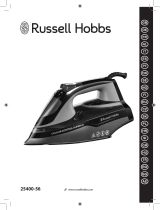
Problem Cause Solution
The selected ironing temperature is too
low for steam ironing.
Select a temperature of 2 or
higher.
When the iron has been set to a very
high temperature, the steam produced is
dry and hardly visible. It will be even less
visible when the ambient temperature is
relatively high and it will be entirely
invisible when the temperature has been
set to MAX.
Set the iron to a lower
temperature, e.g. 2, to check if
the iron is actually producing
steam.
Water droplets
come out of the
soleplate.
The temperature dial may be set to a
temperature that is too low for steam
ironing.
Select an ironing temperature
that is suitable for steam ironing
(temperature settings 2 to
MAX).
You may not have switched on the iron. Set the iron switch to ‘on’ and
wait until the iron is hot.
You may have placed the steam tank on
an unstable and/or uneven surface.
Place the steam tank on a stable
and even surface.
When you start steam ironing and when
you have stopped steam ironing for a
while, the steam that was still present in
the supply hose will have cooled down
and condensed into water, which causes
water droplets to come out of the
soleplate.
This is perfectly normal. Hold the
iron over an old cloth and press
the steam activator. The cloth
absorbs the drops. After a few
seconds, the steam production
normalises.
Flakes and
impurities come
out of the
soleplate.
The iron is new. This is normal. The particles are
harmless ans stop coming out of
the soleplate when you have
used the iron a few times.
The soleplate is
dirty.
You may have ironed at a temperature
that is too high.
Clean the soleplate with a damp
cloth. Select the recommended
ironing temperature.
Impurities or chemicals present in the
water have deposited in the steam vents
and/or on the soleplate.
Clean the soleplate with a damp
cloth.
Dirty water
comes out of the
soleplate.
Too much scale and minerals have
accumulated inside the steam tank.
Rinse the steam tank. See chapter
‘Cleaning and maintenance’.
The iron
produces steam
continuously.
You have slid the steam activator to the
locking position.
Release the steam lock if you
only want to obtain steam when
pressing the steam activator.
ENGLISH12










